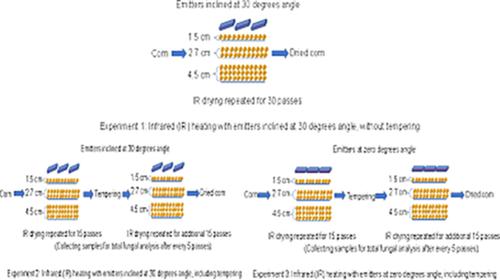当前位置:
X-MOL 学术
›
J. Food Saf.
›
论文详情
Our official English website, www.x-mol.net, welcomes your
feedback! (Note: you will need to create a separate account there.)
New infrared heat treatment approaches to dry and combat fungal contamination of shelled corn
Journal of Food Safety ( IF 1.9 ) Pub Date : 2021-01-27 , DOI: 10.1111/jfs.12886 Zeinab Mohammadi Shad 1 , Abass A. Oduola 1 , Shantae Wilson 1 , Deandrae Smith 1 , Soraya Shafiekhani 1 , Rebecca Bruce 1 , Griffiths G. Atungulu 1
Journal of Food Safety ( IF 1.9 ) Pub Date : 2021-01-27 , DOI: 10.1111/jfs.12886 Zeinab Mohammadi Shad 1 , Abass A. Oduola 1 , Shantae Wilson 1 , Deandrae Smith 1 , Soraya Shafiekhani 1 , Rebecca Bruce 1 , Griffiths G. Atungulu 1
Affiliation

|
Commercial application of infrared (IR) heat has been hampered by a lack of readily available data adaptable to high‐throughput (HT) drying requirements in the grain processing industry. This study evaluated the effectiveness of a continuous flow IR heating system to simultaneously dry and decontaminate corn over various drying bed thicknesses (1.5, 2.7, and 4.5 cm). Additionally, impacts of intermediate tempering treatment and variation of IR emitter angle (zero [E‐0] and 30 [E‐30] degrees) on drying and decontamination of the corn were determined. Although IR heating was able to dry and decontaminate corn at the initial moisture content (MC) of ≈21% wet basis (w.b.), moisture removal was most effective at the least bed thickness (1.5 cm). At 1.5 cm bed thickness, a safe storage MC (<14%) was achieved after 15 min of IR heating. At all the bed thicknesses, IR heating with intermediate tempering resulted in higher fungal inactivation than IR heating without tempering. Infrared heating of corn at 1.5 cm bed thickness plus tempering resulted in a total fungal count (TFC) reduction of 3.1 and 4.6 log CFU/g using IR emitters at E‐30 and E‐0° angles, respectively. However, increasing the bed thickness to 2.7 cm resulted in a TFC reduction of 4.8 and 4.6 log CFU/g using E‐30 and E‐0, respectively. Infrared heating using E‐0, compared to using E‐30, accelerated TFC reduction when corn samples were dried at 1.5 cm bed thickness. These results could help guide the design of HT corn drying and decontamination systems.
中文翻译:

新的红外热处理方法可以干燥和抵抗带壳玉米的真菌污染
缺乏适合于谷物加工行业高通量(HT)干燥要求的现有数据,阻碍了红外(IR)热的商业应用。这项研究评估了连续流红外加热系统在各种干燥床厚度(1.5、2.7和4.5厘米)上同时干燥和净化玉米的有效性。此外,还确定了中间回火处理和红外发射器角度变化(零[E-0]和30 [E-30]度)对玉米干燥和去污的影响。尽管红外加热能够以约21%湿基(wb)的初始水分含量(MC)干燥和净化玉米,但在最小床层厚度(1.5 cm)上,水分去除最为有效。在1.5厘米的床厚下,经过15分钟的红外加热后,可获得安全的存储MC(<14%)。在所有床层厚度下,与不进行回火的红外加热相比,进行中间回火的红外加热导致更高的真菌失活率。玉米在1.5厘米床厚加上回火的红外加热下,使用红外发射器分别以E-30和E-0°角将总真菌计数(TFC)降低了3.1和4.6 log CFU / g。但是,将床厚度增加到2.7 cm,使用E-30和E-0时,TFC分别降低了4.8和4.6 log CFU / g。与使用E-30相比,使用E-0进行红外加热可加快玉米样品在1.5厘米床厚下干燥时TFC的降低。这些结果可以帮助指导高温玉米干燥和去污系统的设计。5厘米的床厚加上回火后,使用红外发射器分别在E-30和E-0°的角度下,总真菌计数(TFC)降低了3.1和4.6 log CFU / g。但是,将床厚度增加到2.7 cm,使用E-30和E-0时,TFC分别降低了4.8和4.6 log CFU / g。与使用E-30相比,使用E-0进行红外加热可加快玉米样品在1.5厘米床厚下干燥时TFC的降低。这些结果可以帮助指导高温玉米干燥和去污系统的设计。5厘米的床厚加上回火后,使用红外发射器分别在E-30和E-0°的角度下,总真菌计数(TFC)降低了3.1和4.6 log CFU / g。但是,将床厚度增加到2.7 cm,使用E-30和E-0时,TFC分别降低了4.8和4.6 log CFU / g。与使用E-30相比,使用E-0进行红外加热可加快玉米样品在1.5厘米床厚下干燥时TFC的降低。这些结果可以帮助指导高温玉米干燥和去污系统的设计。当玉米样品以1.5厘米床厚干燥时,加速了TFC的降低。这些结果可以帮助指导高温玉米干燥和去污系统的设计。当玉米样品在1.5厘米床厚下干燥时,加速了TFC的降低。这些结果可以帮助指导高温玉米干燥和去污系统的设计。
更新日期:2021-04-06
中文翻译:

新的红外热处理方法可以干燥和抵抗带壳玉米的真菌污染
缺乏适合于谷物加工行业高通量(HT)干燥要求的现有数据,阻碍了红外(IR)热的商业应用。这项研究评估了连续流红外加热系统在各种干燥床厚度(1.5、2.7和4.5厘米)上同时干燥和净化玉米的有效性。此外,还确定了中间回火处理和红外发射器角度变化(零[E-0]和30 [E-30]度)对玉米干燥和去污的影响。尽管红外加热能够以约21%湿基(wb)的初始水分含量(MC)干燥和净化玉米,但在最小床层厚度(1.5 cm)上,水分去除最为有效。在1.5厘米的床厚下,经过15分钟的红外加热后,可获得安全的存储MC(<14%)。在所有床层厚度下,与不进行回火的红外加热相比,进行中间回火的红外加热导致更高的真菌失活率。玉米在1.5厘米床厚加上回火的红外加热下,使用红外发射器分别以E-30和E-0°角将总真菌计数(TFC)降低了3.1和4.6 log CFU / g。但是,将床厚度增加到2.7 cm,使用E-30和E-0时,TFC分别降低了4.8和4.6 log CFU / g。与使用E-30相比,使用E-0进行红外加热可加快玉米样品在1.5厘米床厚下干燥时TFC的降低。这些结果可以帮助指导高温玉米干燥和去污系统的设计。5厘米的床厚加上回火后,使用红外发射器分别在E-30和E-0°的角度下,总真菌计数(TFC)降低了3.1和4.6 log CFU / g。但是,将床厚度增加到2.7 cm,使用E-30和E-0时,TFC分别降低了4.8和4.6 log CFU / g。与使用E-30相比,使用E-0进行红外加热可加快玉米样品在1.5厘米床厚下干燥时TFC的降低。这些结果可以帮助指导高温玉米干燥和去污系统的设计。5厘米的床厚加上回火后,使用红外发射器分别在E-30和E-0°的角度下,总真菌计数(TFC)降低了3.1和4.6 log CFU / g。但是,将床厚度增加到2.7 cm,使用E-30和E-0时,TFC分别降低了4.8和4.6 log CFU / g。与使用E-30相比,使用E-0进行红外加热可加快玉米样品在1.5厘米床厚下干燥时TFC的降低。这些结果可以帮助指导高温玉米干燥和去污系统的设计。当玉米样品以1.5厘米床厚干燥时,加速了TFC的降低。这些结果可以帮助指导高温玉米干燥和去污系统的设计。当玉米样品在1.5厘米床厚下干燥时,加速了TFC的降低。这些结果可以帮助指导高温玉米干燥和去污系统的设计。











































 京公网安备 11010802027423号
京公网安备 11010802027423号